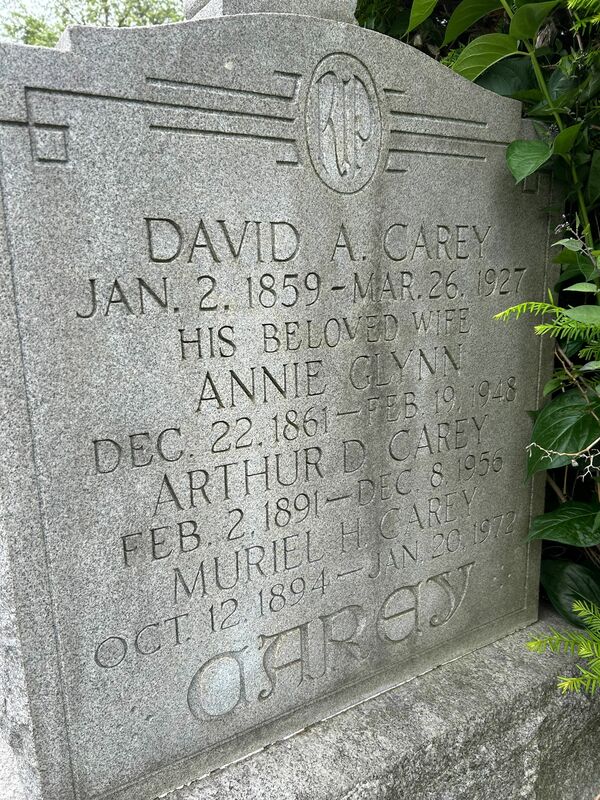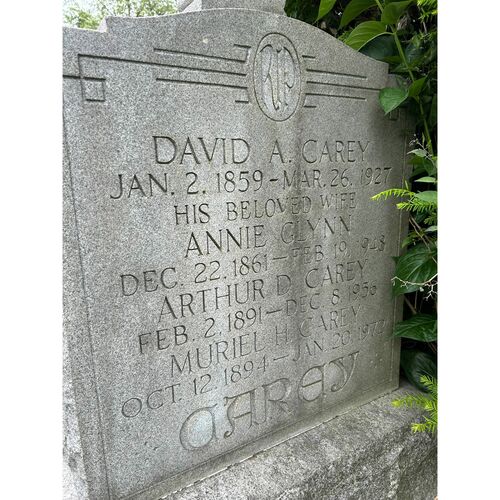
Source: Link
CAREY, DAVID ARTHUR, machinist, newspaper reporter, trade-union leader, and office holder; b. 2 Jan. 1859 in Dublin, son of John Carey and Elizabeth Carter; m. first 31 July 1878 Agnes Theresa Monaghan in Toronto; m. there secondly 19 Oct. 1886 Annie Glynn, and they had a daughter and two sons; d. there 26 March 1927.
David A. Carey immigrated to Canada with his family in 1861 or 1862. They lived in Quebec and Montreal, where David was educated in separate schools. After apprenticing as a machinist, he moved to Toronto and found work as a stove mounter and then in the agricultural implements factory of Hart Almerrin Massey*. In 1878 Carey married Agnes Monaghan, but the union ended tragically: she died at age 19 on 2 Feb. 1879, a day after giving birth to twin girls – one was stillborn, the other lived only six months. David remarried in 1886; for several years the Careys lived on Markham Street and, like many families, they supplemented their income by taking in a boarder.
During the 1880s Carey played an important role in the Toronto labour movement. In 1882 he had joined the Knights of Labor Maple Leaf Local Assembly 2622, which consisted primarily of Massey employees, and he served as district master workman for five years. Along with other experienced labour figures, notably printer Daniel John O’Donoghue*, tailor Alfred Fredman Jury*, painters Charles March* and John W. Carter, and journalist Thomas Phillips Thompson*, Carey outlined strategies that would shape the course of the movement for the next decade. Observing that labour’s interest had been damaged by the public, partisan activity of various Knights leaders, particularly Alexander Whyte Wright*, Carey resolved in 1891 that the order’s District Assembly should cancel the credentials of any delegate who worked for the Conservatives or the Reformers. His denunciation of political involvement resulted in a shift in labour lobbying from the Knights’ legislative committee to the Trades and Labor Congress of Canada, a move that would weaken the Knights’ position.
Carey also belonged, in these years of turmoil, to the Toronto Trades and Labor Council, which had been pivotal in the organization of the Trades and Labor Congress in 1883. He represented the TTLC at the TLC’s annual meetings in 1894, 1895, 1896, 1900, and 1901, and was president of the TLC in 1896–98. At its convention in 1897 he called for concrete reforms, such as public employment bureaus, and broad social and political action, to eradicate the defective “social customs” that were holding back Canada’s toilers. “The educating and new power of the press, properly described as the library of the workingman and the reception of political power, have infused new ideas, new principles and new aspirations into the heads and hearts of the workers,” he maintained. This interest in the press may have been prompted too by Carey’s shift of careers: about 1892 he had become a reporter with the Toronto Evening Telegram.
During this era the TLC struggled to define the position of Canadian labour more exactly with reference to the American Federation of Labor. Canadian locals demanded a greater share of its income, and some trade unions even wanted separation from the giant international. The movement for autonomy had begun at the 1894 meeting of the TLC, where a committee composed of Carey, Quebec machinist Patrick Joseph Jobin*, and Ottawa market gardener James W. Patterson proposed that the congress reconstitute itself as a Canadian labour federation with the power to issue charters and perform all the other duties of a national labour organization. At the convention the following year, however, the congress’s leaders showed a reluctance to work towards autonomy. Two years later a motion to establish a Canadian federation was defeated.
Although the question of international as opposed to national unionism had been settled, the problem of having large numbers of organized workers in Canada paying dues to essentially American organizations remained. In 1898 Carey and TLC secretary George W. Dower (a Toronto typographer) met with Thomas Kidd, who had recently been selected as the AFL’s first fraternal delegate to the TLC. They discussed a proposal by the AFL to make a $100 grant to the TLC to aid its legislative committee and curb dissatisfaction among its members. The TLC accepted the proposal and elected Carey as its first fraternal delegate to the AFL. The TLC was apparently unaware that the AFL was acting in its own interest. By 1901 Carey was clearly pitching the AFL line: more pure labour legislation and less direct political involvement. A Canadian federation was set up by unions expelled from the TLC in 1902, but it remained weak. This failure to organize an effective national body ultimately paved the way for the dominance of the AFL style of international unionism.
Carey remained active in the local labour movement. He served on the board of directors of the Toronto Labor Temple Company Limited from its formation in 1904, was its president for many years, and worked on numerous arbitrations. He was a familiar figure among Toronto workers, particularly those on the waterfront and at Union Station, where his duties as a reporter often took him. A bandsman in his youth, Carey was active as a representative and district officer of the American Federation of Musicians, which had been formed in 1896 and had expanded into Canada in 1901. According to the Labor Leader (Toronto), he was responsible for “many conciliations between irate theatre proprietors and orchestras.”
In October 1917 Newton Wesley Rowell*, a member of the newly formed federal Union government, pushed Carey’s name for the post of undersecretary of labour. Carey had, helpfully, dampened resistance against conscription within the TLC and, Rowell believed, he could speak for Ontario’s Irish Catholics, who felt under-represented in Ottawa. In the general election in December, Carey ran in Toronto South under the Independent Labor banner, but his candidacy was tainted by questions about his motives for going to Ottawa, and he lost to Charles Sheard. About 1925 he left the Telegram to become manager of the Labor Temple, situated on Church Street.
A devout Roman Catholic, Carey served on Toronto’s Separate School Board for 35 years. He worshipped at St Mary’s Church on Bathurst Street, was a founder there of St Mary’s Athletic Association, and belonged to the Third Order of St Francis and the Knights of Columbus. He later attended St Francis’ Church on Mansfield Avenue, where his son Harold became the curate; his daughter entered the Sisters of St Joseph.
While attending the convention in May 1926 of the American Federation of Musicians in Salt Lake City, Utah, Carey experienced heart trouble, which would continue to plague him. He died at his home on Montrose Avenue in Toronto in March 1927 and was buried in Mount Hope Cemetery.
AO, RG 80-2-0-138, no.37217; RG 80-5-0-78, no.12930; RG 80-5-0-147, no.14775; RG 80-8-0-59, no.17075; RG 80-8-0-1050, no.2675. Mount Hope Cemetery (Toronto), Gravestone and burial records. LAC, RG 31, C1, 1901, Toronto, Ward 5, div.11: 3 (mfm. at AO). St Michael’s Cemetery (Toronto), Burial records. Globe, 28 March 1927. Labor Leader (Toronto), 1 April 1927. R. H. Babcock, Gompers in Canada: a study in American continentalism before the First World War (Toronto and Buffalo, N.Y., 1974). Canadian annual rev., 1903-4, 1917, 1921, 1923. Canadian men and women of the time (Morgan; 1912). CPG, 1918. Directory, Toronto, 1883-1927. Eugene Forsey, Trade unions in Canada, 1812–1902 (Toronto, 1982). G. S. Kealey, Toronto workers respond to industrial capitalism, 1867–1892 (Toronto and Buffalo, 1980). G. S. Kealey and B. D. Palmer, Dreaming of what might be: the Knights of Labor in Ontario, 1880–1900 (Toronto, 1987). H. A. Logan, Trade unions in Canada: their development and functioning (Toronto, 1948). Middleton, Municipality of Toronto. James Naylor, The new democracy: challenging the social order in industrial Ontario, 1914–25 (Toronto, 1991). Margaret Prang, N. W. Rowell, Ontario nationalist (Toronto and Buffalo, 1975).
Cite This Article
Christina Burr, “CAREY, DAVID ARTHUR,” in Dictionary of Canadian Biography, vol. 15, University of Toronto/Université Laval, 2003–, accessed January 15, 2026, https://www.biographi.ca/en/bio/carey_david_arthur_15E.html.
The citation above shows the format for footnotes and endnotes according to the Chicago manual of style (16th edition). Information to be used in other citation formats:
| Permalink: | https://www.biographi.ca/en/bio/carey_david_arthur_15E.html |
| Author of Article: | Christina Burr |
| Title of Article: | CAREY, DAVID ARTHUR |
| Publication Name: | Dictionary of Canadian Biography, vol. 15 |
| Publisher: | University of Toronto/Université Laval |
| Year of publication: | 2005 |
| Year of revision: | 2005 |
| Access Date: | January 15, 2026 |



